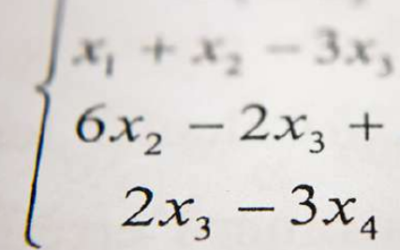Recently, I discovered the math activities of Ronit Bird. Ronit Bird is the author of several books about Dyscalculia. She has helpful tips for parents and teachers about concrete manipulatives and building up a sense of number through activities more than worksheets. I confess, I wish I had had this more when I was a kid. The tricky thing about math and activities even if you’re home schooling or home-enriching is that students who are weak in an area will often not want to do it, even if it’s something that would be beneficial for them to do. In our family, we had one child who was very, very good at all types of speed-based computer games, and another who was decidedly not good […]
The Double Whammy: Dyscalculia and Dysgraphia [Premium]
What happens when a student has both dyscalculia and dysgraphia? Be prepared for an educational path that has a timing of its own. Dysgraphia often accompanies dyslexia, but dyscalculia too. If you or your student has two or three out of these 3 “d’s” be prepared for a challenging course and a need for individualization for many years. The most typical presentation for dyscalculia relates to students who have trouble mastering the sequence of numbers and recall of basic math facts. When dysgraphia gets added to the mix, you can imagine how it may swamp working memory, causing students to lose track when they work through math problems. In a very real sense having both dyscalculia and dysgraphia also robs students of being able to […]
Algebra: What Students See and What Mathematicians See [Premium]
Ben Orlin is the author of Math with Bad Drawings and Change is the only Constant: The Wisdom of Calculus in a Madcap World. Besides have a good sense of humor, Ben is good at recognizing the differences in the way students and mathematicians see math problems. Take for example, the math problem, What is 7 x 11 x 13. What goes through your mind when you see a problem like that? I reach for my calculator, or might try 7 x 11 first, then look for a pen a paper, but what Ben suggests is that mathematicians imagine this. The following examples Ben shared about Algebra had me laughing aloud: The mathematician’s simplification involves recognizing a pattern. But […]
Diagramming Math [Premium]
When we tested older students in our clinic who were in college on STEM tracks, I often asked students who were proficient in mathematics, what strategies were most helpful to them. Many of them found their own ways of solving problems – often using spatial and mental math strategies or diagrams. How did they learn these approaches? Most said they figured it out themselves. In my search for math curricula that emphasized deeper understanding and diagrammatic thinking, I came across two resources that may be valuable for you – Illustrative Mathematics and Japanese Math. Often, we may be reminded that mathematics has its own language. There are words and symbols that mean different things in every day speaking, reading, and writing vs. math. If […]
Spatial Intelligence: Developing One of the Dyslexic Super Powers [Premium]
Although spatial intelligence is often a “dyslexic super power” and associated with famous architects, filmmakers, inventors, and engineers, it gets surprising little education in K-12 education. What that might mean in a practical way is that many of the young members of this community might only stumble into their greatest talents by chance, or worse, not at all. MOST CURRICULA ONLY SPECIFY NAMING AND SORTING SHAPES Math educator David Fielker noticed a surprising blind spot when it comes to math instruction with shapes: typically students are led to practice sorting and verbally classifying shapes, rather than working with them, building, adding, and taking away. It’s physically working with them, “composing and decomposing shapes, comparing and mentally manipulating two- and three-dimensional figures, and […]
Reversing COVID Slide In MATH
]"Early testing data from this fall seem to bear out that the pandemic has hit students harder in math than reading." With increasing numbers of the population getting vaccinated, there's hope for more normalcy, but chances are with all of the disruptions and stress,...
Keeping Math Alive
Among the many challenges facing dyslexic students in the midst of the pandemic is holding on to skills and continuing to make progress in the midst of disruptions and altered schedules due to the pandemic. Because so much math builds on previous knowledge, many...
How a 13-Year Old Dyslexic Girl Helped Save Britain: Hazel Hill
"My mother was partially dyslexic, and she had terrible trouble spelling. This got her into trouble as she was obviously highly intelligent, so teachers thought she was naughty and lazy. I think when she did mathematics, she had none of these problems, which is why it...
Talking Through Math [Premium]
As the pandemic continues, more and more parents and tutors may find themselves supervising students’ math. For dyslexic students, the talking process can be especially valuable, but it may be difficult. If you are a parent or tutor helping explain a lesson or homework, it’s good to help your student talk through the steps of math; this may be especially difficult for some students. If a student has trouble finding words or has a limited working memory, talking through math may be difficult for a while until either or both of these functions develop. Such students may especially benefit when YOU talk through math, slowly and precisely. There are also ways to make the talking process easier – like having a list of math vocabulary […]
How to Avoid the Pandemic Wrecking Ball
The Boston Globe recently published an article saying that COVID-19 has been a wrecking ball for students struggling to read: "Instead of reading, we got websites and circle time.” "Daniel’s progress came to an abrupt halt after Medford Schools closed down in...
Reading and Mathematics [Premium]
“Mathematics texts are more conceptually dense than almost any other type of text…Additionally, reading mathematics often differs from other types of reading because in addition to reading left to right and top to bottom, students must jump around the page to associate text with tables, graphs, symbols, and vice-versa…” The subject of reading in math class often receives very little attention in explicit instruction, because most math teachers receive little training in the specific needs of dyslexic students; in some cases, neglect of these needs may the primary reason that students underperform in this important school subject. Math teachers get little or no instruction in teaching students with dyslexia, although dyslexic students are likely to comprise 1 in 5 of their students. “…many mathematics textbooks […]
Not Falling Behind in MATH
"The studies vary in how severe they gauge the so-called “COVID slide” to be, but all of them found on average, students would lose more ground in math than in reading. Three studies based on NWEA data predicted students could learn half or up to a full year less math...

![Hands-on Math and Games with Ronit Bird [Premium]](https://www.dyslexicadvantage.org/wp-content/uploads/2021/07/Math-Games-5-400x250.png)
![The Double Whammy: Dyscalculia and Dysgraphia [Premium]](https://www.dyslexicadvantage.org/wp-content/uploads/2021/06/Dysgraphia-and-Dyscalculia-400x250.png)
![Algebra: What Students See and What Mathematicians See [Premium]](https://www.dyslexicadvantage.org/wp-content/uploads/2021/06/Algebra-1-400x250.png)
![Diagramming Math [Premium]](https://www.dyslexicadvantage.org/wp-content/uploads/2021/05/math-diagram-400x250.png)
![Spatial Intelligence: Developing One of the Dyslexic Super Powers [Premium]](https://www.dyslexicadvantage.org/wp-content/uploads/2021/05/Spatial-Intelligence-326x250.png)



![Talking Through Math [Premium]](https://www.dyslexicadvantage.org/wp-content/uploads/2021/04/Talking-Through-Math-Dyslexia-318x250.png)

![Reading and Mathematics [Premium]](https://www.dyslexicadvantage.org/wp-content/uploads/2021/03/Frayer-Model-390x250.png)














